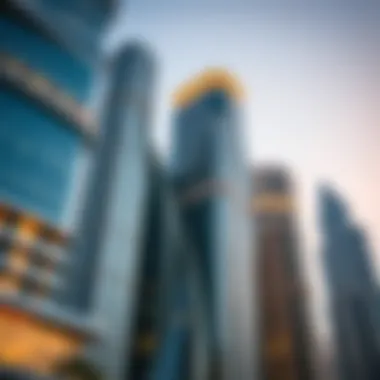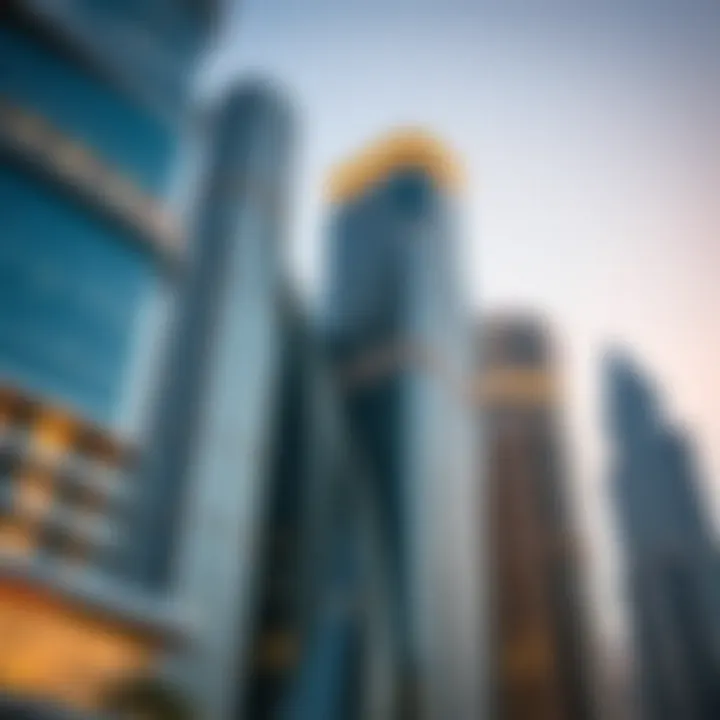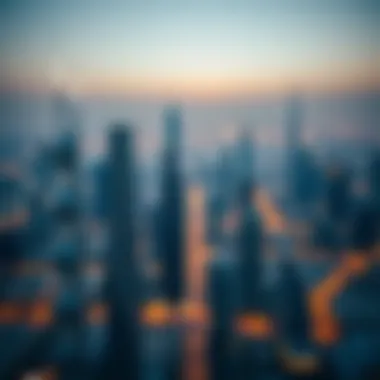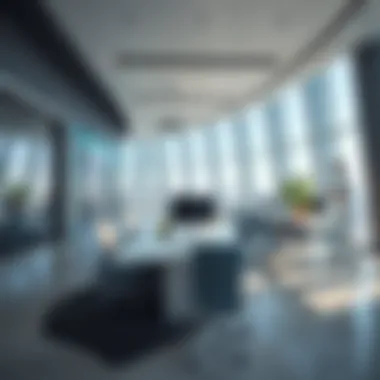The Rise of Skyscrapers in the UAE: Innovations and Impacts
Intro
In the bustling landscape of the United Arab Emirates, particularly within its crown jewels—Dubai and Abu Dhabi—the skyline is defined by ambitious skyscrapers reaching for the heavens. These architectural feats didn't just spring up overnight; they represent decades of evolution, a reflection of the country’s commitment to innovation, design, and economic growth. As we explore the intricate tapestry of skyscrapers in the UAE, it is crucial to understand not just their architectural marvels but also the socio-economic implications and cultural narratives they hold.
Here, we’ll look at how these towering structures embody the aspirations of a nation and what they signify for the future. While the world knows the Burj Khalifa, standing tall as the tallest building on Earth, it’s just one of many striking examples that demonstrate the UAE’s dedication to redefining urban living.
Understanding the trends and economic dynamics prompting skyscraper construction provides crucial context for investors, homeowners, expatriates, and developers alike. As we delve into market trends and investment strategies, this article aims to offer a comprehensive guide that enhances our appreciation of these modern marvels, reminding us that they are more than just buildings; they are living narratives of a nation in constant pursuit of the extraordinary.
Preface to UAE Skyscrapers
The rise of skyscrapers in the UAE has not only transformed the architectural landscape but also redefined the very essence of urban living. As towering symbols of ambition and progress, these structures encapsulate the aspirations of a nation that has rapidly evolved from its modest beginnings to a global hub for business, tourism, and culture. The importance of understanding the development of these skyscrapers lies in recognizing their multifaceted impacts on society, the economy, and the environment.
Historical Background
When tracing the roots of skyscrapers in the UAE, one must consider the original vision set forth by the nation's leaders. In the late 20th century, following the discovery of oil, the UAE, particularly Dubai and Abu Dhabi, began to invest heavily in infrastructural development. This period marked a significant shift from traditional low-rise structures towards high-rise buildings, catching the world’s attention. The early skyscrapers, such as the Al Khaleej Center completed in 1989, laid the groundwork for the architectural marvels that would follow.
The architectural journey reflects not just a change in height but also a shift in design philosophy, marrying contemporary aesthetics with traditional influences. As these cities welcomed expatriates and tourists from across the globe, skyscrapers began to embody cultural narratives unique to the UAE. Each structure told a story, interweaving local traditions with cutting-edge technology, showcasing a promise of progress.
Development Milestones
The evolution of skyscraper construction in the UAE reached several key milestones, each contributing significantly to the nation’s skyline, global image, and real estate market. Notable developments include:
- Burj Khalifa (2010): Standing at 828 meters, it's currently the tallest structure in the world. This architectural marvel has redefined the concept of vertical living and is a hub for both business and tourism.
- Burj Al Arab (1999): Known for its unique sail-shaped silhouette, this luxurious hotel not only set a new standard for hospitality but also became an iconic symbol of Dubai.
- Etihad Towers (2010): This set of five towers offers a blend of residence, hotel, and retail spaces, emphasizing the idea of a multifaceted urban environment.
These skyscrapers reflect not just a measure of height but also serve as a testament to the innovative spirit of the UAE. They symbolize the rapid transformation that has taken place, illustrating how architectural design can influence identity and growth.
Understanding the importance of these skyscrapers allows investors and developers alike to appreciate the complexities underlying their existence. They are not merely structures but cultural landmarks that foster community interaction and stimulate economic activity. Each addition to the skyline represents not just progress but a future full of potential.
Architectural Innovations
The architectural innovations in skyscraper design have driven the transformation of the skyline in the UAE, particularly in cities like Dubai and Abu Dhabi. As these structures rise above the clouds, they symbolize not just ambition but also a blend of aesthetics and functionality. This section delves into the various aspects of architectural innovations, illuminating their impact on the region’s identity, sustainability efforts, and technological advancements.
Design Philosophy
The design philosophy behind UAE skyscrapers goes beyond mere height; it embodies cultural narratives and futuristic visions. Instead of conforming to a one-size-fits-all approach, architects draw inspiration from local culture, history, and environment. The iconic Burj Khalifa, for instance, mimics the structure of a desert flower, showcasing a deep understanding of the surrounding landscape. This careful design consideration is reflective of a broader trend where each skyscraper tells a story, merging tradition with modernity.
Another critical aspect is the importance of flexibility in design. As cities evolve, so must their structures. Adaptable floor plans are now a priority, allowing buildings to cater to various purposes over time. This flexibility can lead to a more sustainable lifecycle for skyscrapers and contribute positively to urban planning. With rising urban populations, the need for such versatile spaces is more pressing than ever.
Sustainability in Skyscraper Design
In recent years, sustainability has taken center stage in skyscraper construction and design. Architects and developers in the UAE are increasingly focusing on eco-friendly materials and energy-efficient technologies. The Dubai Frame, for example, isn’t merely a stunning visual element; it also emphasizes green spaces, integrating parks within its design, which adds both aesthetic and environmental value. This kind of mindful approach showcases the proactive stance the UAE is taking in addressing climate change and environmental degradation.
Energy consumption is a focal point. Innovations such as energy-efficient glazing, smart HVAC systems, and solar panels contribute to a reduction in a building's carbon footprint. Regulations in the UAE are evolving to push for greener designs as across-the-board benefits include reduced operating costs and enhanced occupant comfort. Incorporating renewable energy sources not only aligns with global sustainability goals but also positions the UAE as a leader in the green building movement.
Smart Building Technologies
As technology rapidly advances, the integration of smart systems into skyscrapers has become a game-changer within the UAE. Smart building technologies leverage advanced software and sensors to enhance operational efficiency and occupant experience. For instance, the implementation of Internet of Things (IoT) devices creates a dynamic environment where systems communicate—optimizing a building’s energy consumption and security measures.


Key features of smart skyscrapers include automated lighting systems, smart thermostats, and advanced security systems that make use of facial recognition technology. These technologies not only ensure safety but also provide comfort to residents and tenants, thereby enhancing the value proposition of living and working in these spaces.
There’s also a burgeoning trend of integrating augmented reality in the architectural facets, where prospective buyers and tenants can visualize spaces before their completion. This integration offers a glimpse into how buildings will function and resonates well with tech-savvy investors looking to make informed decisions.
"The true innovation in the UAE's skyscrapers lies in their ability to adapt to the future while honoring the past."
As the UAE continues to push boundaries, embracing these architectural innovations sets the pace for others to follow and redefines the traditional skyline into one of modern opulence and functionality.
Cultural Significance
The skyscrapers of the UAE are more than just monumental structures that scrape the skyline; they are emblematic of cultural identity and societal values. These towering edifices not only showcase architectural prowess but also reflect the aspirations and the indomitable spirit of a nation deeply rooted in tradition yet fiercely invested in modernity. In this section, we will delve into the cultural significance of skyscrapers in the UAE, focusing on their role as symbols of modernity and their impact on the tourism sector, further consolidating the nation’s reputation on the global stage.
Symbol of Modernity
When one gazes at the skyline of Dubai or Abu Dhabi, it's impossible to ignore the striking silhouette of skyscrapers such as the Burj Khalifa or the Burj Al Arab. These structures stand as beacons of innovation, representing a break from the past and an embrace of futuristic ideals. The emerging architecture is heavily inspired by both global trends and local traditions, melding modern aesthetics with cultural heritage.
These skyscrapers symbolize more than just economic growth; they showcase the ambition of a community that transformed its landscape from desolate deserts to vibrant urban centers. In practical terms, the continuous rise of skyscrapers reflects the UAE’s strong commitment to economic diversity, buoyed by revenues from oil, but increasingly driven by sectors like tourism, finance, and technology. This dynamic adds texture to conversations about urban development in the region.
Additionally, the design philosophies behind these structures often integrate local elements, promoting a sense of identity. For instance, the curvature of the Burj Al Arab is reminiscent of the sails of traditional dhows, hinting at the maritime heritage of the region. These choices are not just aesthetic; they are deeply symbolic, bridging the past with the aspirations of a modern UAE.
"Skyscrapers in the UAE are not merely buildings; they are testimonies to what human ingenuity can achieve when married to the right vision and resources."
Tourism and Global Recognition
The architectural wonders of UAE skyscrapers serve as major attractions for tourists from around the world. The grandiosity and unique features of these buildings create experiences that are not merely visual but deeply immersive. As a result, they have become landmarks that draw millions of visitors every year, each looking to catch a glimpse of what makes the UAE a modern marvel.
Travelers flock to see the Burj Khalifa, not just for its height but for the award-winning observation deck that enables breathtaking views of the city spread beneath. The Burj Al Arab, often dubbed the world’s only seven-star hotel, captures the imagination with its opulent design and luxurious offerings. Such spectacles engender a renewed sense of pride among locals and forge a cultural connection between expatriates and the legacy of their host nation.
Moreover, the grandeur of these skyscrapers has helped position the UAE as a nexus for international events, conferences, and exhibitions. This visibility bolsters the national brand and enhances its global recognition, effectively allowing the country benefits that ripple through various sectors. Ensuring that the UAE remains a relevant player in the global economy demands continuous innovation and engagement with cultural narratives.
Hence, the cultural significance of skyscrapers in the UAE extends far beyond their towering heights. They shape the narrative of a nation striving to blend tradition with innovation while fostering a globally recognized identity that resonates across boundaries.
Economic Contributions
The economic benefits of skyscrapers in the UAE extend far beyond their striking visuals and iconic silhouettes against the desert backdrop. These architectural giants have made significant contributions to the economy, which is vital for understanding their role in shaping urban landscapes and fostering growth. With opportunities ranging from real estate investments to job creation, the impacts of these towering edifices resonate throughout various sectors.
Boosting the Real Estate Market
When one thinks of skyscrapers, soaring heights come to mind, but so does the booming real estate market that accompanies them. These structures aren't just buildings; they are hot commodities that attract investors and buyers alike. The UAE has seen a surge in property values as tall buildings redefine prime real estate zones.
- Developers are increasingly keen on optimizing available space, leading to a competitive environment that drives prices higher.
- Areas surrounding skyscrapers often see an appreciation in value, as proximity to these landmarks becomes a desirability factor for potential homeowners and investors.
- An interesting observation is the proliferation of mixed-use developments, where residential, commercial, and leisure spaces coexist within the same skyscraper. This trend capitalizes on urban density and convenience, further enriching the real estate fabric of cities like Dubai and Abu Dhabi.
The rise of high-end residential units in skyscrapers such as the Burj Khalifa has not only drawn affluent expatriates but also enhanced tourism. Tourists often want to stay nearby or visit these architectural wonders, further boosting the real estate sector.
Job Creation and Economic Growth
The construction of skyscrapers inevitably leads to a ripple effect in job creation. From architects and engineers to laborers and project managers, the workforce required for such monumental projects is substantial. This contributes directly to the local economy by reducing unemployment rates and increasing disposable income.
- The booming construction landscape means that jobs are not just limited to building; there is also demand for services ranging from interior design to hospitality, which feeds into the ongoing economic growth.
- Post-construction, skyscrapers often generate employment through the businesses they host, including restaurants, retailers, and offices. Jobs created in these towers support the growth of the service industry, which is crucial in a city heavily reliant on tourism and local spending.


"The skyscrapers of the UAE serve as catalysts for economic opportunities, showcasing that the foundations of an economy can be built as high as the buildings themselves."
The interconnectedness of these developments with the broader economic framework illustrates the invaluable role that skyscrapers play. They aren’t merely symbols of wealth and ambition; they are pillars of the economic structure, contributing to a robust and dynamic marketplace essential for the UAE's future.
Notable Skyscrapers in the UAE
The UAE's skyline is characterized by a collection of distinguished skyscrapers that have not only changed the face of its cities but have also solidified the country’s reputation as a hub of innovation and ambition. Each structure tells a story of technological achievement, architectural creativity, and the cultural aspirations of a nation. In this section, we will explore some of the most iconic skyscrapers, highlighting their significance and impact on the urban landscape.
Burj Khalifa: The Pinnacle of Ambition
Burj Khalifa stands as a testament to human ingenuity and ambition. Towering at a staggering height of 828 meters, it is not just the tallest building in the world, but a beacon of progress for the UAE. Construction started in 2004 and was completed in 2010, with the building quickly becoming a must-see for tourists and a symbol of national pride.
What sets Burj Khalifa apart is its mix of design and functionality. The three-part design inspired by the Hymenocallis flower is both aesthetically pleasing and engineered for structural integrity. Visitors can ascend to the observation deck on the 148th floor, where they are treated to panoramic views of the city below. This building constantly reminds us of the ambitious spirit of the UAE in pursuing heights—both literal and metaphorical.
Burj Al Arab: A Symbol of Luxury
When one thinks of luxury in architecture, the Burj Al Arab often comes to mind. Its distinctive sail shape has made it an icon not just in the UAE but around the world. Since its opening in 1999, the hotel has been synonymous with opulence; featuring lavish suites, exceptional service, and exclusive amenities, it regularly attracts high-profile visitors and tourists eager to experience a taste of luxury.
Burj Al Arab is more than just a hotel; it’s a statement about the UAE’s rise as a luxury destination. This structure also plays a vital role in the tourism sector, captivating those who want to experience its remarkable interior design and stunning views of the coastline. It serves as a reminder that innovation often goes hand in hand with elevated luxury, striking a balance that delights travelers from all over the globe.
Etihad Towers: A Modern Landmark
Located in Abu Dhabi, the Etihad Towers comprise five stunning structures that emphasize modernism and elegance. Completed in 2011, these towers are more than just residences; they house offices, hotels, and retail spaces, creating a mixed-use environment that promotes both work and leisure. The towers have unique architectural designs, with their gleaming glass facades reflecting the sunlight and the surroundings beautifully.
Moreover, one of the towers features a viewing platform that offers breathtaking views of the UAE capital, becoming a popular spot for both residents and tourists. The Etihad Towers stand as a model of integrated urban development, blending business and hospitality while creating a vibrant community atmosphere.
Future Projects: Sky Isn't the Limit
Looking toward the future, the UAE is planning many ambitious skyscrapers that will continue to shape its skyline. Projects such as Dubai Creek Tower, which aims to surpass the height of Burj Khalifa, and Meydan One Tower, are just a few examples indicating that the UAE remains dedicated to pushing the envelope in architectural design and engineering.
These future skyscrapers promise to incorporate sustainable technologies and smart city concepts, ensuring that they not only stand tall but also contribute positively to the environment and society. With such ambitious goals, the UAE continues to be a global leader in innovative urban development, proving that indeed, the sky isn't the limit.
The development of these notable skyscrapers has a profound impact on the economic fabric of the UAE, driving tourism, attracting businesses, and inspiring future generations to reach for the stars.
Challenges in Skyscraper Construction
The construction of skyscrapers in the UAE represents not just a leap in architectural ambition but also a complex juggling act of various challenges. These hurdles can significantly affect not only the success of individual projects but also the skyline of cities like Dubai and Abu Dhabi. Addressing these challenges is crucial, as it helps ensure that skyscrapers not only meet the aesthetic and functional needs but are also safe, sustainable, and culturally resonant.
Technological Hurdles
Building taller structures requires specialized technology that often isn't easy or cheap to come by. The UAE's extreme climate, with its high temperatures and strong winds, poses unique challenges for structural integrity and safety. Engineers face the daunting task of developing materials that can withstand these environmental pressures while ensuring the comfort of occupants.
One major hurdle is ensuring the stability of foundation designs, particularly on reclaimed land. The soil composition and seismic activity need thorough analysis. Advanced technologies like 3D modeling and structural simulation play pivotal roles. They allow engineers to project performance under different scenarios, thus minimizing risks.
Additionally, the integration of elevators in such tall structures demands innovative solutions. For example, companies like Thyssenkrupp have explored the use of ropeless elevator systems that can move both vertically and horizontally, thus optimizing space usage while improving traffic flow within buildings.
Environmental Concerns


As the UAE aims to position itself as a leader in sustainability, skyscraper construction methods and materials must also consider environmental impacts. The carbon footprint from construction activities can be significant, making it essential to adopt eco-friendly practices.
The selection of materials is a key point here. Many developers are experimenting with recycled materials and local sourcing to mitigate transportation emissions. Skyscrapers equipped with energy-efficient systems can sharply reduce ongoing operational costs and their environmental impact. Green roofs and solar panels have become almost a standard in new developments, enhancing biodiversity and reducing heat absorption in urban areas.
At the same time, water usage remains a pressing concern. The demand for long-term water supply in a desert environment poses challenges. Innovative water recycling systems can substantially lower usage, echoing a broader trend towards sustainability in urban planning.
Future of Skyscrapers in the UAE
As the landscape of the UAE continues to evolve, the future of its skyscrapers plays a central role in shaping urban identity and functionality. The ambitions of architects and developers in this dynamic region are shared with a global audience, who are keenly observing how these structures blend form and purpose. Future skyscrapers in the UAE are not just about attaining greater heights; they represent a confluence of sustainability, technology, and social trends.
Emerging Trends in Architecture
In light of advancements in materials and design philosophies, we're witnessing a shift towards buildings that prioritize sustainability and multi-functionality. Architects in the UAE are adopting biophilic design principles, which integrate natural elements into urban structures. The aim is to create harmony between the bustling life of the city and the tranquility of nature.
Some notable trends include:
- Green Roofs: These not only enhance aesthetic appeal but also provide insulation and help reduce urban heat.
- Vertical Gardens: Acting as natural air filters, they contribute positively to the environment.
- Modular Construction: This method allows for quicker assembly and minimizes waste, making it a favorite among forward-thinking developers.
- Adaptive Reuse: Existing structures are being retrofitted with new technologies to serve modern needs without disturbing the historical context, blending the past with the present.
These practices reflect a commitment to innovative solutions that address pressing environmental concerns while ensuring functional spaces for both work and leisure.
Impact of Global Economic Factors
The future of skyscrapers in the UAE does not exist in a vacuum; it is intricately linked to global economic trends. As the world economy fluctuates, so too does investment in architecture and real estate. Recent events have shown that economic stability in major regions influences the financial climate for development projects.
Investors today seek adaptability within their projects—whether it's fluctuating construction costs, the demand for energy-efficient designs, or changing consumer preferences. Furthermore, cultural events like the Expo 2020 have paved pathways for international collaboration, drawing attention to local innovation while enhancing tourism.
It’s essential to consider:
- The emergence of cryptocurrency and digital finance plays a role in funding skyscraper projects, allowing for new avenues of investment.
- Geopolitical stability in the region creates an inviting environment for international businesses, thus driving demand for premium office and residential spaces.
- Economic diversification strategies being employed by the UAE government aim to reduce reliance on oil revenues, bolstering sectors such as tourism and technology, which aligns with skyscraper projects targeted at attracting new settlers and businesses.
The intricacies of global economics and local ambitions intertwine, ensuring that the future of skyscrapers in the UAE remains as vibrant and innovative as ever. With every new structure, there's a story being told, encapsulating the region’s resilience and forward-focused vision.
Closure
In the grand scheme of urban development, skyscrapers in the UAE have carved a niche that is as significant as it is transformative. This section sheds light on the importance of understanding the concluded findings of this article. The skyscrapers have gone beyond mere structural entities; they embody the UAE's ambition, innovation, and cultural identity.
Recap of Key Points
To summarize the critical elements discussed:
- Historical Context: We examined the evolution of skyscrapers in the UAE, focusing on how historical influences shaped their current form.
- Architectural Innovations: Innovations like sustainability practices and smart building technologies were highlighted, illustrating how they revolutionize design philosophies.
- Cultural Impact: The skyscrapers serve as symbols of modernity and have significantly boosted tourism, enhancing the global perception of Dubai and Abu Dhabi.
- Economic Contributions: Each project has not only uplifted the real estate market but also generated job opportunities, propelling economic growth in the region.
- Challenges and Future Trends: We acknowledged the hurdles faced in construction, considering environmental concerns and technological difficulties, while also discussing the emerging trends poised to define the future of these architectural giants.
Final Thoughts on the Skyscraper Landscape
As we stand at a crossroads in architectural progress, it's essential to reflect on how skyscrapers in the UAE embody the aspirations of a nation with a vision. They are more than buildings; they are beacons of opportunity and symbols of what can be achieved through innovation and resilience. The journey of these towering structures is a testament to the UAE's unyielding determination to define its urban landscape. Investors and stakeholders alike must consider the intricate balance between growth, sustainability, and cultural integrity as they navigate this dynamic sector. The skyscraper skyline is still evolving, and its story is far from over.
"The skyline of a city is the gateway to its identity and spirit."
As we look towards future developments, there remains an undeniable excitement about what the next phase of architectural innovation will bring. With a promising horizon ahead, the skyscrapers of the UAE will continue to shape not only the physical landscape but also the very essence of a progressing society.
For further reading, consider visiting:
- Wikipedia on Skyscrapers
- Britannica - Influence of Skyscrapers
- Reddit Discussions on Urban Architecture
Through this analysis, it becomes evident that the UAE's skyscraper landscape presents unique opportunities and challenges that will profoundly influence future generations.



